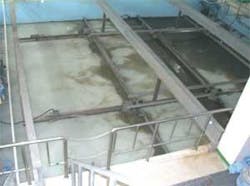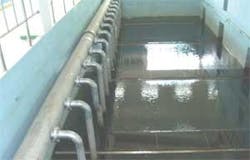F.B. Leopold Provides DBP Solution in South Korea
The Songjeon Water Treatment Plant (SWTP) was the first facility to install dissolved air flotation clarification to ensure safe drinking water in the Korean Peninsula.
By James E. Farmerie
The Songjeon Water Treatment Plant is operated by the Korean Water Resources Corp. (K–Water). It obtains raw water from the Hoeng–Seong (HS) Lake. The reservoir – with 87 million m3 storage capacity – has algal blooms, high turbidity when there are rainfall events, and requires powdered activated carbon (PAC) to enhance organic removals and prevent chlorinated disinfection by–products (DBPs) such as total trihalomethanes (TTHMs), dichloroacetic and trichloroacetic acid (HAA2), and chloral hydrate (CH).
Background
The raw water supply from HS lake historically had algae (average counts 2,455 cells/ml), low turbidity (average 6.1 NTU), low hardness (average 28 mg/L as CaCO3), and low alkalinity (average 21.6 mg/L). From 2000–03, turbidity during and after rainfall events varied to spikes over 300 NTU. K–Water designed a system that would be flexible and handle a variety of raw water conditions. The plant was designed for flow rates of 100,000 m3/hr (26.4 MGD). The process treatment scheme included a pre–sedimentation basin, a Leopold® Clari–DAFTM – a dissolved air flotation (DAF) system, and Leopold FilterWorxTM gravity filters with Type S® Underdrain, I.M.S.® (Integral Media Support) Cap, with sand (250 mm) and anthracite (1,750 mm) media, and backwash troughs. The purpose of the pre–sedimentation basin was to divert flow during rain events to allow heavy high–density solids to settle out prior to treatment through the DAF system flotation process.
null
Treatment Results
The plant was built and commenced operation in 2003. Currently, the coagulant chemical feed is polyaluminum chloride and lime, averaging 12 mg/L and 2 mg/L respectively. The G value, which defines the amount of mixing taking place and is calculated uses power input, volume and viscosity of liquid (where the higher the value, the more violent the mixing), in the flocculators is 70 sec–1 in the first stage, and 50 sec– in the second stage. The loading rate is 16.3 m/hr (6.7 gpm/ft2) based on collector area, while the recycle rate is 10% in the summer and 7% during the other nine months. Since start–up of the facility, the average raw turbidity has been 5 NTU, DAF system effluent 0.3 NTU, and filter effluent 0.04 NTU. Rain events have resulted in raw water turbidities ranging from 64 to 430 NTU. During those times, 2.3 to 16.5 NTU turbidity remained in the effluent from the pre–sedimentation process. This turbidity was reduced by the DAF system to 0.14 – 1.1 NTU and then by the filter to 0.02 – 0.09 NTU producing a stable water quality.
When removing organics in the raw water, K–Water has elected to reduce the level of chlorinated by–products below the criteria mandated in Korea and the United States as listed in Table 1.
To help the plant meet the goals, PAC was fed prior to the addition of the coagulant. Table 2 summarizes the average concentrations of chlorinated by–products in the effluent water with PAC addition from April 2005 to March 2006 and without PAC addition from April 2004 to March 2005.
With PAC, concentrations of TTHMs and CH were all unchanged, but HAA2 was reduced by 9 ug/L. This is significant because, of the three chlorinated by–products, HAA2 has been the biggest problem in most Korean potable water treatment plants. During this study, the pre–sedimentation basin observed an increase in turbidity when feeding PAC, while the DAF system showed excellent efficiency for removing turbidity. While feeding PAC, and with raw water turbidity of 3.5 NTU, the pre–sedimentation basin average effluent went from 1.9 NTU to 2.8 NTU, while the DAF system effluent yielded a slight increase from 0.15 to 0.23 NTU. Plant personnel continue to investigate additional methods to further reduce chlorinated by–products.
null
Author’s Note:
James E. Farmerie is product manager for clarification solutions at F.B. Leopold Co., a unit of ITT Corp. – which acquired the Zelienople, Pennsylvania, USA–based water and wastewater specialist in 2006. Contact: 724–452–6300, fax: 724–452–1377 or www.fbleopold.com



